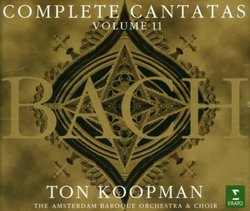| All Artists: Johann Sebastian Bach, Ton Koopman, Christoph Prégardien, Klaus Mertens, Amsterdam Baroque Orchestra and Chorus, Annette Markert Title: Bach Complete Cantatas Vol. 11 / Amsterdam Baroque Orchestra · Koopman Members Wishing: 1 Total Copies: 0 Label: Elektra / Wea Release Date: 4/17/2001 Genre: Classical Styles: Opera & Classical Vocal, Historical Periods, Baroque (c.1600-1750) Number of Discs: 3 SwapaCD Credits: 3 UPC: 685738021529 |
Search - Johann Sebastian Bach, Ton Koopman, Christoph Prégardien :: Bach Complete Cantatas Vol. 11 / Amsterdam Baroque Orchestra · Koopman
 | Johann Sebastian Bach, Ton Koopman, Christoph Prégardien Bach Complete Cantatas Vol. 11 / Amsterdam Baroque Orchestra · Koopman Genre: Classical These nine cantatas--performed here as part of Ton Koopman's complete series for Erato--were written in 1724-25, during Bach's second year in Leipzig, for specific feast days of the Church calendar. All are constructed on ... more » |
Larger Image |
